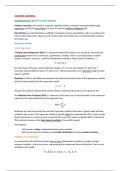Summary
Samenvatting An Introduction to Statistical Learning - Machine Learning (F000942)
- Course
- Institution
- Book
Summary of the Machine Learning course at Ghent University, given by Dries Benoit. For Data Science for Business and Business Engineering, first master
[Show more]




